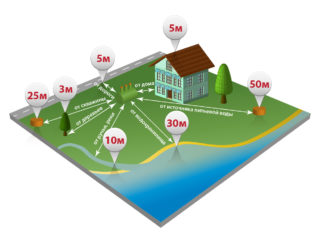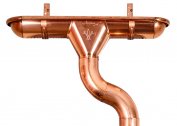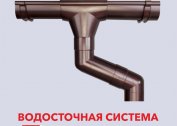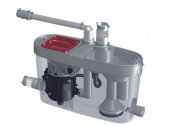A sanitary protection zone (SPZ) is a section of the territory on which local treatment facilities (LOS) are built. Their area is calculated by the possible degree of spraying (dispersion) of harmful substances in sewage. The larger the emissions, the wider the area. SPZ of sewage treatment facilities according to SanPiN standards is also determined based on the type of VOC - open or closed. Additionally, the type of installed equipment is taken into account.
Basic rules for industrial SPZ
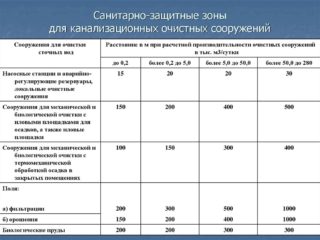 Sanitary protection zones for their purpose are divided into two groups: industrial and domestic. Each type has its own requirements for the location, area and degree of wastewater treatment.
Sanitary protection zones for their purpose are divided into two groups: industrial and domestic. Each type has its own requirements for the location, area and degree of wastewater treatment.
In SanPiN, the dependence of the size of the SPZ on two parameters is indicated: the technical equipment of the local sewer systems and the cleaning capacity, measured in thousand m³ / day. If the VOC is equipped with pumps, sumps and emergency tanks, the relationship is:
| Productivity, thousand m³ / day. | up to 0.2 | 0,2-5 | 5-50 | 50-280 |
| SPZ size, m | 15 | 20 | 20 | 30 |
If VOC equipment includes facilities for a specific purpose — for mechanical and biological treatment — as well as silt sites where sewage sludge is fermented, the size of the protection zone must be increased:
| Productivity, thousand m³ / day. | up to 0.2 | 0,2-5 | 5-50 | 50-280 |
| SPZ size, m | 150 | 200 | 400 | 500 |
If thermomechanical treatment of sewage sludge is added to mechanical and biological treatment, and all this happens in enclosed spaces, the SPZ parameters are as follows:
| Productivity, thousand m³ / day. | up to 0.2 | 0,2-5 | 5-50 | 50-280 |
| SPZ size, m | 100 | 150 | 300 | 400 |
In addition to active wastewater treatment, local treatment networks use facilities that belong to the category of post-treatment. These are filtration or irrigation fields, the so-called biological ponds. For them, too, there are norms that are defined by SanPiN. Here the dependence is the same, on the power of VOCs.
| Productivity, thousand m³ / day. | up to 0.2 | 0,2-5 | 5-50 | 50-280 |
| SPZ size, m
filter fields irrigation fields biological ponds |
200
150 200 |
300
200 200 |
500
400 300 |
1000
1000 300 |
The latest sewage treatment technologies and equipment that is being introduced into the sewer network increase the degree of purification. This reduces the area on which it is installed. Therefore, legislative documents are amended and supplemented. If the efficiency of the filtration and irrigation fields, mechanical and biological treatment facilities is increased, then the size of the SPZ can be reduced to 100 m, provided that:
- filtration fields are located on the territory of up to 0.5 hectares;
- irrigation fields up to 1 ha;
- performance of cleaning systems does not exceed 50 m³ / day.
If underground filtering fields are constructed and their productivity does not exceed 15 m³ / day, the VOC size can be taken within 50 m. If the surface runoff of treatment plants has an open design, the size of the sanitary protection zone can be 100 m, with a closed type the size decreases to 50 m. If the VOC includes drain stations, the zone parameter increases to 300 m.
If industrial treatment facilities are located outside the territory of the production facility and domestic sewage is connected to them, the SPZ parameters are determined by the values indicated in the above tables.
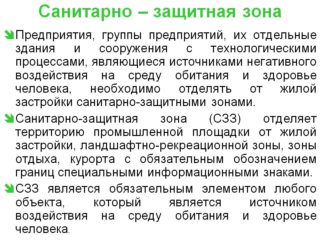 In sanitary protection zones for local treatment facilities it is prohibited:
In sanitary protection zones for local treatment facilities it is prohibited:
- build residential buildings;
- carry out landscape work;
- organize recreation areas, motels, resorts, health facilities;
- to build cottage villages and form garden associations;
- build sports and playgrounds.
In the industrial-type sanitary protection zone, it is impossible to organize food and pharmaceutical industries, to build warehouses where food and medicine products, raw materials and semi-finished products are stored. It is impossible to build water supply systems where water is purified and stored.
A few more requirements for sanitary zones of sewer systems:
- SPZ should be located on the leeward side relative to the industrial facility and residential buildings located nearby;
- when designing, it must be taken into account that in the future local treatment facilities will expand;
- VOCs are being built taking into account the gravity flow of sewage, as well as surface-type wastewater - the entire territory is located under a slight slope;
- when determining the size of the SPZ, the type and class of the enterprise are taken into account.
The design of the sanitary protection zone determines the approximate size. Regulatory calculations are formulated in SanPiN. But over time, during operation, the size of the SPZ can change up or down. Based on observations and various measurements of the air condition, the final (established) size of the SPZ is approved.
The criterion by which the final zone parameter is determined is the permissible (limit) concentration of pollutants. This parameter is measured at the border of the zone.
The size of the SPZ can be reduced if new cleaning technologies are introduced in VOCs and new highly efficient equipment is installed, or the enterprise itself is redesigned - its capacity, composition or hazard class is reduced.
The road that runs inside the sanitary protection zone is not taken into account when calculating the size of the SPZ. Automobile emissions are necessarily taken into account for pollution.
Domestic Sanitary Protection Zones
The rapid development of suburban construction has led to the emergence of a large number of local sewer systems located directly on the suburban area. They are small in size, many are equipped with fields or filtration wells.
Manufacturers offer septic devices with a high degree of purification of sewage and sewage, which is brought up to 99%. But no matter what type of VOC is used in the suburban area, what is its degree of purification, the standards and requirements for all types are the same:
- the distance to the foundation of the house is not less than 5 m;
- to the well or well, on the basis of which an autonomous water supply system of the house is formed, - at least 50 m
- to open reservoirs - 30 m;
- to the neighboring site - 3 m;
- to plantations - 3 m;
- to the road passing near the site - 5 m.
In SanPiN there are standards that determine the size of the filtering fields. The latter belong to the VOCs and form the SPZ. The calculation of the area occupied by the filtration fields is established by the ratio of the daily volume that the septic tank gives out and the soil absorption capacity.
